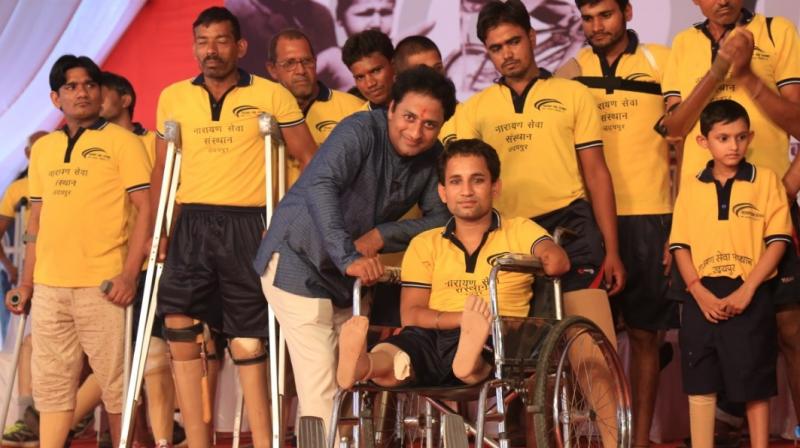Need more focus for professional development of specially-abled in India?

In India, as per Census 2011, 2.68 crore people were recorded disabled of the total population of over 121 crore. Furthermore, 45 per cent of the disabled population is uneducated and a significant amount of that population lives in rural areas. Differently-abled people too deserve growth in all aspects of life, be it physical, economic or social, and they require a dedicated platform to help them attain a place in society. Surgeries and basic education help with it to some extent, but what they really require is a platform where they can learn skills to set up their career and get ahead in their professional life.
The Rights of Persons with Disabilities Act 2016 in India right now considers 21 disabilities, which confirm to international standards. These include intellectual and physical disabilities such as Autism, Cerebral Palsy, Parkinson’s disease, and Muscular Dystrophy among others. Under the Act, discrimination against persons with disabilities, inequality and refusal to their rights can result in legal action.
Differently-abled individuals, specifically in rural areas face a lot of difficulties, even more than persons with disabilities in urban areas in India. There is often lack of understanding and sympathy for differently-abled people in rural areas. People with disabilities are either tied up in a corner in rural areas or treated brutally further worsening their condition. In many cases with mentally ill individuals, they’re thought to be possessed and then are taken through a whole different course of “cures”.
The biggest reason behind them is the lack of awareness and education among people about disabilities. Due to lack of facilities, individuals with disabilities barely have any accessibility in public areas such as markets, schools. There are almost no special educations programs designed for specially-abled people in rural India, where they can learn at their own pace and can be taught as per their special needs. This result in students with disabilities most often dropping out of schools, or lagging way behind their peers. Furthermore, they are not guided or oriented about career aspects for them in the future and what paths they can choose after school.
Technology came as a boon for specially-abled individuals
The emergence of technology has helped a lot in many aspects with differently-abled persons. Not only has technology made better education possible, it has also helped improve the ways of communication with specially-abled people. For example, a blind person can make calls or type texts just with the help of voice to text feature. There are apps which help persons with disabilities track their progress everyday and help them monitor their health, behavior etc.
Technology is also now helping kids learn in a better way in classrooms. Assistive technology, be it any app, software or device, helps kids improve communication, social skills, academic skills and more. It also helps kids with maintaining attention, improving their comprehensive issues, writing, reading and speaking skills. Assistive technology helps in smoothening students’ lifestyle, working on their weaknesses and making them more productive.
Various courses for persons with disabilities
Technology has helped education easier for persons with disabilities. There are now several online courses which can help differently-abled individuals learn professional skills and find jobs out in the world. Several offline courses are also available, made easier and accessible with the help of technology. These courses provide specially-abled individuals with professional degrees, to further help them in their professional life. Several colleges and universities have many such courses ranging from three months to one year. Some of these courses are:
Digital Photography: Instead of using films and paper sheets to produce pictures, students are taught how to click pictures using a digital camera, and even specific smartphones and how to edit, store and share them using a computer. Students are taught how to use photography software’s, computer software’s and publish these photographs on different platforms.
Graphic Design: A Graphic designing course includes studio art, principles of design, computerized design, commercial graphics production, printing techniques, and website design. Students should also have beforehand knowledge of writing. A flair for creativity is required to become a graphic designer, a profession that has become really popular in the last few years.
Management Accounting: The course helps students learn about commerce, financial services at consultancies, government public sector or manufacturing industry. Students learn about evaluating business activities and analyzing stakeholders and regulators.
App Development: Apps are a significant part of every Smartphone and given the increasing number of Smartphone users, app development is becoming an important course to reach out to specifically Indian audiences. Students are taught the basics of creating apps and what goes into the making of them.
Wealth Management: The course teaches financial planning and asset allocation, and makes students into skilled professionals to handle corporations’ finances. Students learn how to handle both personal and corporate finances. The course teaches about equity market analysis, mutual funds and investment planning.
Government initiatives, NGOs and several companies’ CSR activities are now focusing on how to help specially-abled individuals grow and become more skilled professionally. As a result of this, several new courses are being introduced to help them get ahead in life.
The author of the article Mr Prashant Agarwal is the president of Narayan Seva Sansthan, a non-profit organization serving differently able and underprivileged individuals.

